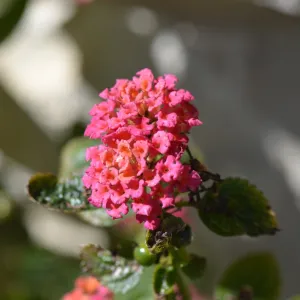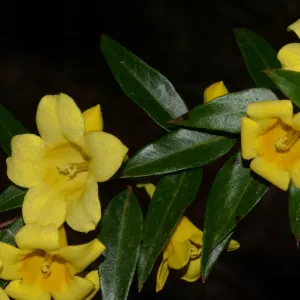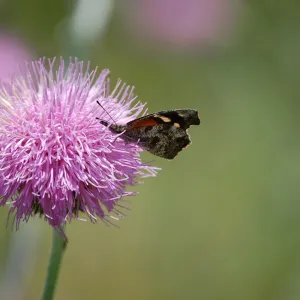by Delmar Cain – Boerne Chapter, Native Plant Society of Texas
Published in Boerne Star on February 12, 2016

After a wet fall that normally happens in an El Nino year, I thought it might be time to consider spring plantings. But then January moved in, the sunny days started, and the rains stopped. Near the house I still have blooms on a lantana that usually drops its leaves in cool nights of November.
But NOAA still forecasts a colder and a wetter than normal February, March and April.
So on the chance that NOAA is correct and you want to plant something this spring, you might be interested in leaning about two NICE recommendations of the Boerne Chapter of the Native Plant Society (NPSOT). The NICE (Natives Instead of Common Exotics) program was created to give landowners new ideas about native trees, vines, shrubs and flowers that can fill landscapes with colorful, drought and sometimes deer resistant plants that not only look great, but provide food for wildlife as well.

The NICE recommended plant for January 2016 was Carolina jessamine, an evergreen, twinning vine that can reach as high as twenty feet or can mound, depending on its location or your preference. It is found in thickets and growing on fences from Virginia south and west to Texas.
The scientific name for the vine is Gelsemium sempervirens, a member of the Loganiaceae family, which includes many woody vines, some of which are very poisonous. Other common names for the plant are Yellow jessamine, Evening trumpetflower and my favorite, Poor Man’s Rope. And yes the common name is spelled “Jessamine” and not “Jasmine”.
Jasmines belong to another family. Many are non-native species (Confederate jasmine from China and Asian jasmine from Asia), which may or may not be listed as invasive, but still may be difficult to control.
Growing in either full sun or part shade, Yellow jessamine produces showers of yellow, horn-shaped flowers in the spring. With its leaves staying green, but with a purplish hue in winter, it will provide a nice cover for an arbor or trellis. And although every part of the plant is listed as poisonous, its flowers are fragrant and the nectar in its flowers will attract native bees, hummingbirds and a variety of butterflies. However, a Museum of North Carolina website indicates that all parts of the plant contain “strychnine-like toxins,” that may cause sickness if consumed by humans or livestock or skin irritations for those who have a greater sensitivity. On the positive side it is less palatable for deer.
I bought the Carolina jessamine in the photograph at Hill Country African Violets and Nursery, located near the Boerne Stage Road exit on I-10 in Boerne.
The second NICE plant, Spiny hackberry (Celtis ehrenbergiana), is the recommended Plant of the Month for February. But to ask most to consider another hackberry takes a bit of convincing to overcome that old prejudice.
The old prejudice was that a hackberry was trash tree. It didn’t burn well, didn’t split-well for making tools or lumber, didn’t live long, didn’t make good fence posts, was brittle and lost its limbs, but it did show up in all the places where it wasn’t wanted.
But for those of us who now look to Lowe’s or our local hardware store instead of to our land for our tools and lumber we have the luxury of considering other attributes of a hackberry tree, in this case the Spiny hackberry, Desert hackberry or Granjeno.
The wildlife near your home should make the case for planting one or more of this large shrub or small tree in your yard. The mammals will make a path and the birds will flock to eat the yellow to orange fruit that follow the small greenish-white flowers in the spring. The deer will browse the leaves in spite of the spiny thorns on the branches. Unlike the Poor Man’s Rope every part of this shrub is edible.

With this small tree in your yard normally no taller than 14 feet, you might get to watch a small piece of an outbreak or population explosion of American snout butterflies, which use hackberry species including this one as a host. When you drive down the road in your car and the unlucky ones hit your windshield, you will be able to tell your children or grandchildren, “I know where all these snout butterflies came from.”
Spiny hackberry is native to South Texas and the Edwards Plateau. In a severe cold it may freeze back if not protected. If established, it will return in the spring. If you have an area that needs erosion control, this plant can do the job. The animals, birds, bees and other insects will thank you by their “performance art” at the plant.
Marvin Hatter, a member of Boerne Chapter of NPSOT and wonderful grower, has grown some Spiny hackberries from seeds from a plant in San Antonio. NPSOT will be selling them at the NPSOT booth at the Mainly Native Plant Sale in April. Marvin will also be delivering a program on growing native plants at the monthly Boerne NPSOT meeting on March 1, 2016. The group meets at the CNC at 6:30 PM and the public is welcome.
To see a series of 4 images of Spiny hackberry (sometimes still listed scientifically as Celtis pallida Torr.) go to Texas ArgiLife Extension website for Plants of the Texas Rangelands at: http://essmextension.tamu.edu/plants/plant/spiny-hackberry-granjeno/
More images of the Poor Man’s Rope can be found on the Wildflower Center website at: http://www.wildflower.org/plants/result.php?id_plant=GESE
Planting instructions for both of these plants may be found under the NICE heading on the Boerne NPOSOT website at: http://www.npsot.org/wp/boerne/
